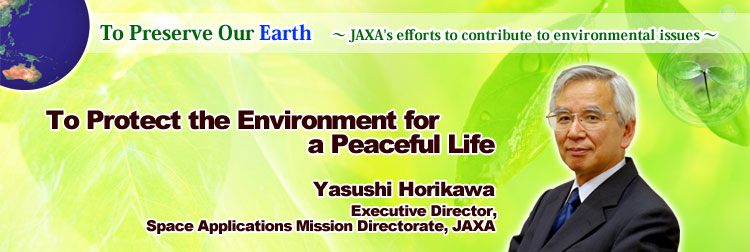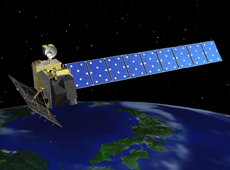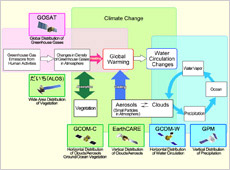
Earth-observation satellites can view the entire surface of our planet from space, which is beneficial in a variety of fields. The first Earth-Observation Summit (EOS) was held in 2003, attended by ministerial-level representatives from countries involved in Earth observation. International organizations also participated in this meeting. Currently more than seventy countries and members of European Commission, and more than fifty international organizations, are participating in the intergovernmental Group of Earth Observation (GEO), which was formed at EOS in 2003.
Former Prime Minister Junichiro Koizumi attended the second EOS in Tokyo in April 2004. At the third EOS in 2005, a ten-year implementation plan was drafted for the establishment of the Global Earth-Observation System of Systems (GEOSS). GEOSS is now being promoted in cooperation with various countries from around the world, including Japan.
The vision for GEOSS was defined for nine social benefit areas: disasters, health, energy, climate, water, weather, ecosystems, agriculture, and biodiversity. The Council for Science and Technology Policy of the Cabinet Office of the Government of Japan decided that Japan should prioritize global warming, climate change and disasters. As a part of Japan's strategy, JAXA's satellites will contribute to global warming countermeasures by increasing the accuracy of climate change predictions through the following four missions.
- Greenhouse Gases Observing Satellite (GOSAT)
- Global Change Observation Mission (GCOM)
- Global Precipitation Measurement Mission (GPM)
- Earth, Clouds, Aerosols, and Radiation Explorer (EarthCARE)
An investigation has begun to develop a disaster-monitoring satellite to follow the Advanced Land-Observation Satellite Daichi (ALOS), which was launched in 2006.
JAXA is continuing its work on a plan for satellites to observe the entire Earth from various aspects. We will continue to develop projects that contribute to global efforts to protect the environment. The lifespan of an Earth-observation satellite is usually about five years. Five years of observations is not sufficient to obtain enough data to predict the climate of the Earth one hundred years from now. Thus, we need to launch several consecutive satellites, one after another, to make observations for at least 10 or 15 years.
The GCOM project will be JAXA's first attempt at long-term observations. This mission involves a series of satellites to observe various global changes, such as water circulation, atmospheric conditions, vegetation, and the color of the sea. There will be three generations of satellites to perform more than ten years of observations.
The GCOM project will be JAXA's first attempt at long-term observations. This mission involves a series of satellites to observe various global changes, such as water circulation, atmospheric conditions, vegetation, and the color of the sea. There will be three generations of satellites to perform more than ten years of observations.

Marine-Observation Satellite-1 (MOS-1) Momo-1
Japan was the fourth country to launch a satellite, following the Soviet Union, the United States and France. We are devoted to achieving an advanced space-development program. We also have more than twenty years of experience in Earth observation, having launched the Marine-Observation Satellite Momo-1 as our first Earth-observation satellite in 1987. The international community is looking forward to our future contributions.
JAXA will cooperate with domestic universities and research organizations to combine the best of Japan's abilities and technologies. For example, for radars, the National Institute of Information and Communications Technology (NICT) has a wealth of research experience and has developed various radar observation instruments. JAXA has the knowledge to develop the most advanced functional equipment in space and the ability to put together the right team to produce needed technologies and observation equipment. JAXA will take the lead in creating satellite technologies to make all Japanese people proud.

The Advanced Land-Observing Satellite Daichi (ALOS) contributes to the Sentinel Asia Project.
When satellites and observation equipment are developed, each project is, in a sense, organized vertically, yet we try to promote research on common technologies and data horizontally. For example, we analyze and process satellite data, providing it in usable form to organizations and researchers. The Earth-Observation Research Center (EORC) collects observation data, performs general research on data analysis, and also makes the information available to the general public.
GEOSS is a project that requires international cooperation. JAXA is collaborating with the United States, Europe and Asian countries on projects ranging from the joint development of onboard observation equipment for satellites to sharing data. Together with Asian countries, we have launched Sentinel Asia, a program to monitor natural disasters in the Asia-Pacific region. The Committee on Earth-Observation Satellites (CEOS) was founded in 1984 with the aim of international coordination of Earth-observation projects from space. JAXA is playing a core role in CEOS. We would like to help develop a better society by promoting cooperation between various countries and international organizations.
We would like to make good use of new technologies and knowledge to benefit as many people as possible. For instance, when Earth-observation satellites improve the accuracy of climate-change predictions, it will be useful and beneficial to take specific countermeasures against global warming. We hope this will lead to a safer and more secure existence for people all over the world.
Besides dealing with environmental issues and disasters, observation data can also be used in industries closely related to our daily lives, such as weather forecasting, agriculture, fisheries, and cartography. We would like to provide more accurate, user-friendly data.
Related Link:
Besides dealing with environmental issues and disasters, observation data can also be used in industries closely related to our daily lives, such as weather forecasting, agriculture, fisheries, and cartography. We would like to provide more accurate, user-friendly data.
Related Link:
Dr. Yasushi Horikawa
Executive Director, Space Applications Mission Directorate, JAXA
Dr. Yasushi Horikawa received a Ph.D. in 1973 from the Graduate School of the University of Tokyo. In the same year, he joined the National Space Development Agency of Japan (now part of JAXA). He participated in the development of systems from the Geostationary Meteorological Satellite Himawari (GMS) to Himawari-3 (GMS-3).
Subsequently, Dr. Horikawa was in charge of Earth-observation satellite planning for the Marine-Observation Satellite, Momo (MOS-1), and the Japanese Earth-Resources Satellite, FUYO-1 (JERS-1). In 1987, he was assigned to the International Space Station project, and in 1998, he became a program manager for the Japanese Experiment Module Kibo project. In 2002, he was assigned as a special advisor to the president and since 2005 has been an Executive Director of JAXA.
Executive Director, Space Applications Mission Directorate, JAXA
Dr. Yasushi Horikawa received a Ph.D. in 1973 from the Graduate School of the University of Tokyo. In the same year, he joined the National Space Development Agency of Japan (now part of JAXA). He participated in the development of systems from the Geostationary Meteorological Satellite Himawari (GMS) to Himawari-3 (GMS-3).
Subsequently, Dr. Horikawa was in charge of Earth-observation satellite planning for the Marine-Observation Satellite, Momo (MOS-1), and the Japanese Earth-Resources Satellite, FUYO-1 (JERS-1). In 1987, he was assigned to the International Space Station project, and in 1998, he became a program manager for the Japanese Experiment Module Kibo project. In 2002, he was assigned as a special advisor to the president and since 2005 has been an Executive Director of JAXA.
To Protect the Environment for a Peaceful Life
Measuring Greenhouse Gases from Space
Understanding the Global Water Cycle
Long-term Environmental Change: Observations of Earth
Three-Dimensional Observation of Clouds and Aerosols
Water, Air, and Waste Recycling
Measuring Greenhouse Gases from Space
Understanding the Global Water Cycle
Long-term Environmental Change: Observations of Earth
Three-Dimensional Observation of Clouds and Aerosols
Water, Air, and Waste Recycling
